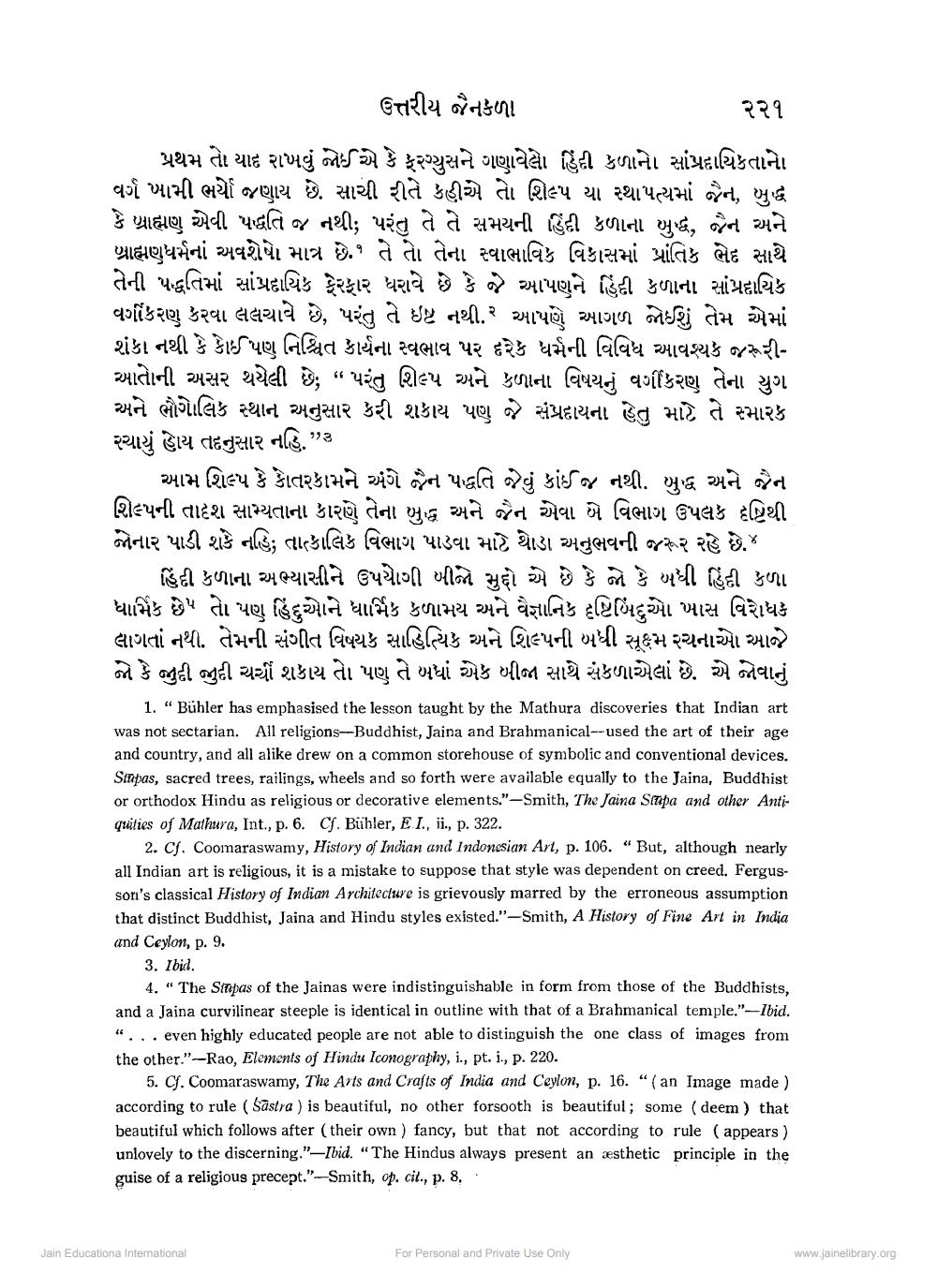________________
ઉત્તરીય જૈનકળા
૨૧
કે
પ્રથમ તે યાદ રાખવું જોઈ એ કે ફર્ગ્યુસને ગણાવેલા હિંદી કળાના સાંપ્રદાયિકતાને વર્ગ ખામી ભર્યાં જણાય છે. સાચી રીતે કહીએ તેા શિલ્પ યા સ્થાપત્યમાં જૈન, બુદ્ધ બ્રાહ્મણ એવી પદ્ધતિ જ નથી; પરંતુ તે તે સમયની હુંદી કળાના યુદ્ધ, જૈન અને બ્રાહ્મણધર્મનાં અવશેષો માત્ર છે. તે તે તેના સ્વાભાવિક વિકાસમાં પ્રાંતિક ભેદ સાથે તેની પદ્ધતિમાં સાંપ્રદાયિક ફેરફાર ધરાવે છે કે જે આપણને હિંદી કળાના સાંપ્રદાયિક વર્ગીકરણ કરવા લલચાવે છે, પરંતુ તે છુ નથી. આપળે આગળ જોઈશું તેમ એમાં શંકા નથી કે કોઈ પણ નિશ્ચિત કાર્યના સ્વભાવ પર દરેક ધર્મની વિવિધ આવશ્યક જરૂરીઆતાની અસર થયેલી છે; પરંતુ શિલ્પ અને કળાના વિષયનું વર્ગીકરણ તેના યુગ અને ભોગેાલિક સ્થાન અનુસાર કરી શકાય પણ જે સંપ્રદાયના હેતુ માટે તે સ્મારક રચાયું હોય તદનુસાર નહિ. ૩
*
આમ શિલ્પ કે કેતરકામને અંગે જૈન પદ્ધતિ જેવું કાંઈ જ નથી. યુદ્ધ અને જૈન શિલ્પની તાદૃશ સામ્યતાના કારણે તેના બુદ્ધ અને જૈન એવા બે વિભાગ ઉપલક દષ્ટિથી જેનાર પાડી શકે નહિ; તાત્કાલિક વિભાગ પાડવા માટે થોડા અનુભવની જરૂર રહે છે.
હિંદી કળાના અભ્યાસીને ઉપયાગી બીજો મુદ્દો એ છે કે જો કે બધી હિંદી કળા ધાર્મિક છે. તો પણ હિંદુને ધાર્મિક કળામય અને વૈજ્ઞાનિક દૃષ્ટિબિંદુ ખાસ વિધિક લાગતાં નથી. તેમની સંગીત વિષયક સાહિત્યિક અને શિલ્પની બધી સૂક્ષ્મ રચનાઓ આજે જો કે જુદી જુદી ચર્ચા શકાય તો પણ તે બધાં એક બીજા સાથે સંકળાએલાં છે. એ જોવાનું
1. "Bühler has emphasised the lesson taught by the Mathura discoveries that Indian art was not sectarian. All religions-Buddhist, Jaina and Brahmanical-used the art of their age and country, and all alike drew on a common storehouse of symbolic and conventional devices. Stupas, sacred trees, railings, wheels and so forth were available equally to the Jaina, Buddhist or orthodox Hindu as religious or decorative elements."-Smith, The Jaina Stupa and other Antiquities of Mathura, Int., p. 6. C⟩. Bihler, E I., ii., p. 322.
2. Cf. Coomaraswamy, History of Indian and Indonesian Art, p. 106. "But, although nearly all Indian art is religious, it is a mistake to suppose that style was dependent on creed. Fergusson's classical History of Indian Architecture is grievously marred by the erroneous assumption that distinct Buddhist, Jaina and Hindu styles existed."-Smith, A History of Fine Art in India and Ceylon, p. 9.
3. Ibid.
4. "The Stupas of the Jainas were indistinguishable in form from those of the Buddhists, and a Jaina curvilinear steeple is identical in outline with that of a Brahmanical temple."-Ibid. "... even highly educated people are not able to distinguish the one class of images from the other.'—Rao, Elements of Hindu Iconography, i., pt. i, p. 220.
ઢ
5. Cj. Coomaraswamy, The Ats and Crafts of India and Ceylon, p. 16. “⟨an Image made) according to rule ( Sāstra ) is beautiful, no other forsooth is beautiful; some (deem) that beautiful which follows after (their own) fancy, but that not according to rule (appears ) unlovely to the discerning."-Ibid. "The Hindus always present an aesthetic principle in the
guise of a religious precept.”—Smith, oh. cit., p. 8,
Jain Educationa International
For Personal and Private Use Only
www.jainelibrary.org




